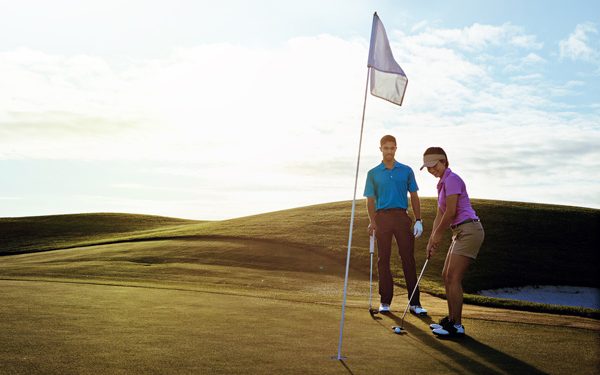Just like other sports, golf demands a combination of various physical and mental attributes in order to maximize performance potential. The physical attributes that contribute to golf performance include endurance, speed, flexibility, mobility, stability, strength, and balance. And just like in other sports- particularly at the recreational level- golf attracts people of all ages, sport backgrounds, and athletic abilities. Therefore, it follows that each golfer who comes to a trainer in search of a golf fitness program will be unique. The best fitness program for golfers is not one-size-fits-all. It is one that is uniquely tailored to the individual’s specific needs.
Body Types and Golfers: Shedding the Traditional Image
Fifteen years ago, when I was competing professionally on the long drive circuit, I struggled to find a trainer who could work with my specific needs. I was lean and lanky, and achieved my distance primarily thanks to my flexibility and hip speed. As a golf professional, I understood that what I needed most in order to crack the top 10 was a little more muscle and a lot more upper body strength- particularly in the forearms and triceps. I was 50-plus pounds lighter than many of the competitors, and I struggled to control the clubhead at higher speeds. However, most trainers I visited would immediately gravitate to recommending additional stretches, leaving out almost entirely any kind of strengthening regimen. Strength and power were mistakenly perceived as relatively unimportant for golfers.
I believe misconceptions originated because many golf fitness programs were first developed with the traditional image of the “typical” golfer in mind: older, male, and saddled with poor posture and limited flexibility. As a result, traditional golf fitness programming revolved around improving flexibility and mobility. While flexibility and mobility certainly play a huge role in both performance and injury prevention, these elements should not be assumed to be the sole components of golf fitness programming.
If we examine the top 10 players on the PGA and LPGA Tours today, we see players of all body types, with different strengths and weaknesses. Lydia Ko is 5 feet 5 inches, while Lexi Thompson is almost 6 feet tall[i]. PGA Tour bios list Dustin Johnson at 6 feet 4 inches and 190 pounds, while Justin Thomas is listed as 5 feet 10 inches and 145 pounds[ii]. Some are tall and lanky, and can generate their clubhead speed through length of arc. Others are short and stocky, and generate their clubhead speed differently. But I would bet that almost every one of them would love to find a fitness regimen that makes the most of their strengths while also improving their weaknesses. Few would want a program that only targets one or the other. We see the same phenomenon among amateur players.
Not only do body types come into play when determining the best fitness program for golfers, but so too do gender and level of play and swing technique. The most common injuries are different between men and women, and among professionals and amateurs[iii]. Typically, men (who have relatively more lower back injuries) can benefit most from flexibility, while women (who have relatively more upper body injuries, particularly in the wrist and elbow) can benefit most from strengthening. However, never assume based on gender or skill level- always conduct a thorough assessment and check for yourself.
Common Issues for Golfers
At this point you’re probably saying to yourself, “OK, I get it- I shouldn’t train all of my golfers the same way. But I’m not a golfer myself. How do I know what they need?”
A good starting point will always be your initial interview and preliminary assessment of the client. It will help guide you in the right direction. NASM offers a Golf Fitness Specialization that builds on the OPT™ model and offers assessments and golf programming information. Another excellent source of information is the Titleist Performance Institute’s website, which offers a repertoire of basic assessments, as well as training recommendations specific to several common swing challenges golfers may be facing. While a great many of these common swing ailments have a lack of flexibility or mobility as contributing causes, trainers shouldn’t focus solely on flexibility and mobility at the risk of neglecting other areas. Here are some other common areas of concern:
- A lack of balance and/or stability may be contributing to golfers swaying off the ball, prematurely raising up out of their posture, or finding themselves in a reverse spine angle- all of which are not only detrimental to their golf performance, but also place the golfer at greater risk of injury. Several top tour players and long drivers are known to incorporate stability ball and balance board training into their regimens.
- Speed and endurance may not be the first things golfers think of when it comes to conditioning, but they are nonetheless important. Many weekend golfers may struggle because they fade coming down the stretch after 4 hours of walking the course. For high-level athletes seeking to hit the ball farther, drills to increase acceleration and rotational speed of the hips and torso will work wonders.
- As previously noted, strength training is still being dismissed in some circles as unnecessary and even detrimental to golfers. However, this is far from the truth. The stronger the muscles, the more control the player will have and the more powerful the swing will be. Training the legs and glutes can contribute to a powerful weight shift, reduce lateral sway, and allow the player to powerfully rotate the hips without raising up out of his or her posture. Strength through the shoulders, triceps, and forearms can help the player keep the clubface square at impact, harness the speed generated by the weight shift and hip turn, and control the path of the club along the target line. Finally, the core is vital and cannot be overemphasized. Since we are not looking to build linebackers or body builders, but rather controlled, quick, explosive strength, plyometric training can be particularly beneficial for golfers.
Conclusions
Golf fitness programming has certainly come a long way since my competitive days. More and more trainers are now aware of the importance of conducting initial assessments of their clients, and of tailoring programming to individuals’ unique needs. However, there is still a risk of succumbing to traditional assumptions about golf and focusing solely on flexibility while overlooking other important components. If you’re not a golfer yourself and are unsure about what might be hindering your client’s performance, I recommend reaching out to your client’s PGA or LPGA professional. The more you can improve your client’s physical limitations, the easier the golf professional’s job will be, and the more progress they will be able to make with the client. Most PGA and LPGA pros will appreciate your efforts and will be happy to work with you to help our mutual clients reach their goals.
References
[i] Women’s World Golf Rankings. Retrieved from: http://www.rolexrankings.com/
[ii] PGA Tour World Golf Rankings. Retrieved from: http://www.cbssports.com/golf/rankings/world-rankings
[iii] Foster, Larry, MD. (2004). Dr. Divot’s Guide to Golf Injuries: A Handbook for Golf Injury Prevention and Treatment.

If you are interested in learning more about Cal U’s online Exercise Science degrees, click here.











